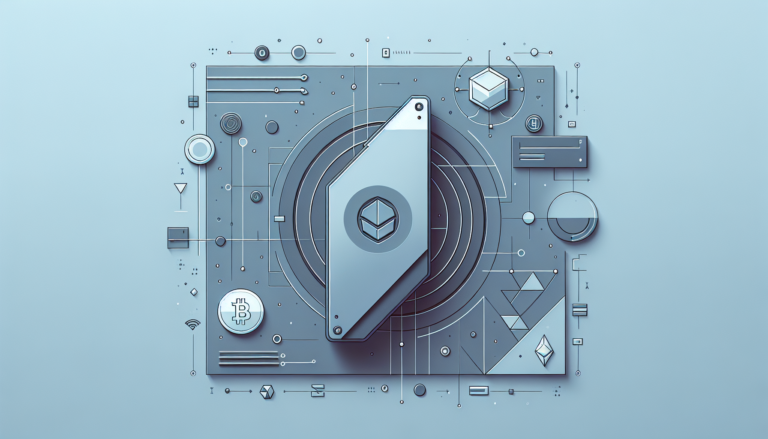My Ultimate Guide: Hardware Wallet Reviews 2021
Understanding Crypto Wallets
Crypto wallets are like the trusty sidekick you need for jumping into the land of digital money. These handy devices or apps store the secret codes (private keys) you need to mess around and keep track of your funky internet currencies. Stick around, I’ll clue you in on the different kinds (sorts) of wallets you can pick from and why keeping your stuff safe is a big deal.
Types of Wallets
There’s a buffet of wallet types for stashing those sacred private keys, from wired-up hot wallets to chill cold wallets, and even those in-between hybrid options.
-
Hot Wallets: Think of these as your go-to for quick cash runs. They hang out on the internet, making them perfect for daily buy-and-sell adventures but, and here’s the hitch, they are open season for hackers and digital pests since they’re lounging online.
-
Cold Wallets: These guys are all about going offline. Picture them as tiny safes, like those chunky old-school car keys or snazzy USB sticks. They keep your keys away from the jaws of the net and are super handy to pocket around. You can sneak around transactions without waving your keys to the digital masses (Kaspersky).
-
Hybrid Wallets: This one’s like the sweet spot, giving you the best of both worlds. They cater to folks who want a bit of security without sacrificing convenience.
| Wallet Type | Description | Security Level | Purpose |
|---|---|---|---|
| Hot Wallet | Online storage | Low | Everyday transactions |
| Cold Wallet | Offline storage | High | Long-term asset storage |
| Hybrid Wallet | Combines both | Medium | Flexible security based on needs |
Importance of Security
Keeping your crypto stash safe is like guarding your kingdom. There’s a whole rogue’s gallery of hackers trying to score big off exchanges and online setups. That’s why hardware wallets have become the darling for storage. They keep your crypto’s personal codes jammed tight, cut off from the cyber nasties, and safe from glitch-infested programs (Kaspersky).
Tucking my keys away in a hardware vault means they’re chilling offline, off the radar from thievery and nosy parkers. If you’re seriously all-in about protecting your digital treasure, you need to think hard about picking the right hardware wallets vs software wallet.
Getting a grip on these basics will point you the right direction for managing and locking up your crypto investments safely. If you’re itching to find out more, I’ve got some juicy reviews and head-to-head wallet smackdowns lined up. Go full-on geek and check out my comparison of crypto wallets or get the scoop on how their safety measures stack up in cryptocurrency wallet security comparison.
Hardware Wallets Overview
I’ve dived into hardware wallets, figuring out what sets different models apart to keep those crypto investments safe and sound. Brands like Trezor and Ledger are old-timers in the crowd, whereas new kids like Ellipal Titan and NGRAVE ZERO are throwing some impressive options into the mix for safe storage.
Trezor vs Ledger
When I look at Trezor and Ledger, they’ve got their own vibes. Trezor is all about making life easy for newbies with its simple software setup, even though Ledger might outgun it with its decked-out features. Ledger’s Nano X is the flashier sibling, handling over 1,800 coins, and it’s got that Bluetooth mojo (PulseChain Forum, Bitsgap).
| Feature | Trezor | Ledger Nano X |
|---|---|---|
| User Interface | Easy peasy | All the bells and whistles |
| Supported Coins | Less | Over 1,800 coins |
| Bluetooth | Nope | Yep |
| Security Incident | Clean record | 2020 scare but cryptos stayed put |
Ellipal Titan Features
Ellipal Titan isn’t shy about its flashy looks and clever tricks. It’s totally cut off from the internet or any tech buddies, giving it a security edge. The easy-to-handle interface lets folks glide through transactions without a hitch. Plus, it cozies up to a bunch of digital coins, so it’s pretty handy for a variety of users.
Key Ellipal Titan bits:
- No internet; safety all the way
- Friendly interface
- Plays nice with lots of cryptocurrencies
NGRAVE ZERO Security
NGRAVE ZERO has a rep for being one super-safe hideout for your crypto treasures. This wallet goes all out with security, boasting full disconnection from the digital grid, a design that’s tough to mess with, and a battery life that might outlive your grandkids (Coin Bureau). Getting through tough security checks, NGRAVE ZERO makes you feel like your assets are in Fort Knox.
Notable NGRAVE ZERO goodies:
- Light sensors and biometric fancy tech for extra safety
- PIN for keeping snoopers out
- Built with military-grade tough stuff
- A layout that’s a breeze to get around
For a deeper look, you might wanna peek at my thoughts on the showdown between a hardware wallet and software wallet and check out the scoop on cryptocurrency wallet security comparison.
Popular Hardware Wallet Reviews
So, you’re rummaging through the jungle of cryptocurrency storage in 2021, hunting for a reliable hardware wallet, yeah? Well, sit tight because I’ve poked around some of the top contenders to see how they stack up in terms of features, security, and overall vibe. Here’s the lowdown on what’s hot and happening in the hardware wallet scene.
Trezor Model T
Meet the Trezor Model T—your dependable sidekick in the wild world of crypto. Since it strutted onto the scene in 2018, hackers have stayed unsuccessful in trying to crack it open from afar. It’s like the superhero of security, taking under its wing a truckload of cryptocurrencies and shaking hands with software wallets like Exodus for a smooth ride.
| Feature | Details |
|---|---|
| Supported Coins | Lots—way more than its starter sibling |
| Security Level | High—think fortress |
| Integration | Cozy with wallets like Exodus |
Ledger Nano X
Enter the Ledger Nano X. This bad boy is rocking support for a whopping 1,800 coins. Fancy Bluetooth? Check. Bigger and better screen? Yup. You can cram in up to 100 apps, making it a hefty little thing. True, a pesky data breach in mid-2020 put a lot of personal info out there, but hey, your digital coins were snug as a bug in a rug through it all.
| Feature | Details |
|---|---|
| Supported Coins | 1,800+—yes, that many! |
| Bluetooth Connectivity | Yep, all wireless and whatnot |
| App Storage | Up to 100—pack ’em in |
Ellipal Titan Review
Now, onto the Ellipal Titan—a sleek warrior in the hardware wallet realm. Its best trick? Keeping your private keys off-grid, way out of the internet’s claws. It’s like building a moat around your treasure, making it a solid option against those shady hack attempts. The whispers about its features still float around, but offline safety? It’s got it down pat.
NGRAVE ZERO Overview
The NGRAVE ZERO is bonkers about security. It’s like Fort Knox, with an air-gapped cybernetic fortress and a “you can’t touch this” tamper-proof design. Oh, and with a battery life that outlasts grandpa’s storytelling sessions—200 years, for real. Serious crypto hounds looking to lock up their digital gold will dig this vault.
| Feature | Details |
|---|---|
| Security Features | Air-gapped, tougher than old boots |
| Battery Life | Gives Energizer Bunny a run—200 years! |
| Usage | Cold storage—icy but secure |
KeepKey Evaluation
Rounding things out, we’ve got KeepKey. With a price tag of $50, it’s like the budget-friendly punk with a bit of sass. A bigger screen makes tapping and clicking easy-peasy. Though it holds fewer coins and sticks only to its pal Shapeshift, it’s still a solid choice for those counting pennies but wanting reliability.
| Feature | Details |
|---|---|
| Price | $50—easy on the wallet |
| Screen Size | Big and bold |
| Integration | Only parties with Shapeshift |
Each pocket protector here has its own twists and turns, suited to different strokes. Whether you’re just dipping your toes or plunging head-first into crypto waters, picking the right wallet makes all the difference. For a deeper dish on wallets, pop over to my chats about hardware wallet vs software wallet and comparison of crypto wallets.
Recent Cryptocurrency Security Incidents
Cryptocurrency is always making headlines with new security scares popping up like the latest viral dance challenge. Recently, a few high-profile incidents caught my eye, shedding light on why choosing the right crypto wallet is basically like picking the best locks for your virtual treasure chest. Let me give you the inside scoop on the M2 Exchange fiasco, the U.S. government’s wallet oopsie, and the Radiant Capital blunders.
M2 Exchange Hack
Picture this: January 3, 2024 – M2 Exchange gets a rude awakening when hackers swipe $13.7 million in valuable digital coins right out of their hot wallets. Talk about a security blind spot! But don’t worry, all’s well that ends well, right? User funds were patched up and operations were back on track, like nothing ever happened. It’s a big ol’ wake-up call that says, “Hey, don’t sleep on your security measures!” Personally, I’d suggest peeking at the best hardware wallet for cryptocurrency if holding onto your assets is a priority.
| Incident | Date | Loss Amount |
|---|---|---|
| M2 Exchange Hack | January 3, 2024 | $13.7 million |
U.S. Government Wallet Breach
Now here’s a head-scratcher: one of Uncle Sam’s very own crypto stashes got tangled up in a hacking scandal. Result? A cool $20 million in Ethereum and stablecoins dressed up and wheeled over to various crypto exchanges. The trail got muddier than a rainy day, making it rough to track down those rogue coins. It’s a not-so-gentle nudge to tighten up security – even the suits need to step up their tech game.
| Incident | Date | Loss Amount |
|---|---|---|
| U.S. Government Wallet Breach | Date Unknown | $20 million |
Radiant Capital Attacks
Radiant Capital’s year went from sunny to stormy with two attacks raining on its parade in 2024. The grand finale was on October 16, when hackers turned a USDC market into their personal piggy bank, walking off with a jaw-dropping $58 million. This mess screams for constant vigilance and beefed-up defenses. It’s like playing cat and mouse, and the mouse is always getting sneakier.
| Incident | Date | Loss Amount |
|---|---|---|
| Radiant Capital Attack | October 16, 2024 | $58 million |
So what’s the takeaway? Crypto’s no joke with risks lurking around every corner. Sure, hardware wallets offer more peace of mind than their software counterparts (hardware wallet vs software wallet), but you’ve got to stay sharp about potential threats. If you’re curious about lining up your options, I’ve got the crypto wallets comparison and a cryptocurrency wallet security comparison loaded with details just for you.
Growth of Hardware Wallets
It’s like the crypto world got the memo — keep your coins safe or lose ‘em. Enter the trusty hardware wallet, your digital treasure chest. With more folks wising up to security, these gadgets are flying off shelves faster than you can say Bitcoin.
Market Projection
Hold onto your hats, ‘cause hardware wallet sales are set to soar. They’re looking to skyrocket at a 22.3% growth rate starting 2024 and zooming up to 2030. Check it out in the numbers:
| Year | Projected Growth (%) |
|---|---|
| 2023 | – |
| 2024 | 22.3 |
| 2025 | Who knows? |
| 2026 | Your guess is as good as mine! |
| 2030 | TBD |
This points out how crucial these security gizmos are becoming as digital treasures gain popularity.
User Adoption Rates
Here’s a head-scratcher: even with solid options on the table, only about 2% of crypto folks actually use hardware wallets. Think of the possibilities as more jump on the bandwagon. By the end of 2024, their popularity jumped nearly 50%! Seems like as soon as people figure out that storing coins on risky gadgets isn’t the smartest move, they start switching to more secure methods.
Using these vault-like wallets alongside your good ol’ bank account might make things smoother. The merging of old-school banking with our new digital playground could change the game. Imagine your hardware wallet chumming around with traditional financial names — a match made in crypto heaven, smoothing out those teething problems.
Curious about how different safety nets stack up? I’ve put together a little face-off for you to check out: hardware wallet vs software wallet and cryptocurrency wallet security comparison. Understanding this trend might just help you pick the best hardware wallet for cryptocurrency.
Selecting the Right Hardware Wallet
Picking the perfect hardware wallet is like choosing the right safe for your treasures, but in the crypto universe. Let’s delve into what really matters when making your choice.
Factors to Consider
-
Security Features: You wouldn’t leave your car unlocked, so why be casual with your crypto? These wallets store your private keys offline, giving hackers a lot of trouble. Check for extras like passphrases and firmware that even James Bond would envy.
-
User Interface: Ever struggle with a lemon of a gadget? Avoid that pain by picking a wallet that’s a breeze to use. This is super important, especially if you’re just learning the ropes in the crypto field.
-
Supported Cryptocurrencies: Plan to hoard a mix of coins? Make sure your wallet is ready to handle all of ’em, like a trusty backpack.
-
Price: Sure, hardware wallets can feel pricey compared to software ones, but think of it as investing in the best security team for your crypto stash and weigh the cost against the peace of mind.
-
Physical Security: Imagine the muscle-bound bouncer at the club entrance—that’s what good physical security features do for your wallet, with tamper-proof designs and secure chips keeping the riff-raff out.
-
Backup and Recovery: Picture your seed phrase as a magic key. Keep it offline and away from nosy eyes to ensure you can reclaim your riches even if things go south. Look for wallets that make this as foolproof as possible.
Comparison of Top Models
Here’s a cheat sheet for the big players in 2021’s hardware wallet league, spotlighting main features and security perks.
| Hardware Wallet | Price Range | Supported Coins | Security Features |
|---|---|---|---|
| Trezor Model T | $219 | 1,800+ | Touchscreen, passphrase support |
| Ledger Nano X | $149 | 1,500+ | Bluetooth, encrypted storage |
| Ellipal Titan | $199 | 10+ | Air-gapped, QR code communication |
| NGRAVE ZERO | $369 | 10+ | Encrypted OS, biometric security |
| KeepKey | $49 | 40+ | Backup recovery, PIN protection |
For an honest breakdown of these gadgets, dig into my best hardware wallet for cryptocurrency review.
When weighing up each model’s pros and cons, it’s helpful to peek at our hardware wallet vs software wallet showdown for the bigger picture on storage options. A hardware wallet can provide top-notch protection for your investments, which you can explore more in our cryptocurrency wallet security comparison.






